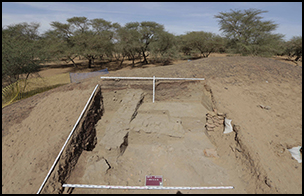Article contents
The ironworking remains in the royal city of Meroe: new insights on the Nile Corridor and the Kingdom of Kush
Published online by Cambridge University Press: 11 February 2019
Abstract

Meroe is one of Africa's most famous archaeological sites, renowned not least for its evidence of ironworking. Yet, the extensive slagheaps that characterise the site have received little archaeological attention. To illuminate the chronology and distribution of these remains, this article combines extant excavation data with the results of recent site-wide surface and geoprospection survey, and ongoing slagheap excavation and radiocarbon dating. The slagheaps date predominantly to either the Early (Napatan) or Late (late/post-Meroitic) periods, with little evidence for activity between c. 300 BC and AD 300—precisely when Meroe was the capital of the Kingdom of Kush—indicating significant reorganisation of the city's industrial base at this time.
- Type
- Research
- Information
- Copyright
- Copyright © Antiquity Publications Ltd, 2019
References
- 6
- Cited by


